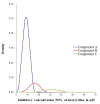PftetQ and pfmdt copy numbers as predictive molecular markers of decreased ex vivo doxycycline susceptibility in imported Plasmodium falciparum malaria
- PMID: 24225377
- PMCID: PMC3831056
- DOI: 10.1186/1475-2875-12-414
PftetQ and pfmdt copy numbers as predictive molecular markers of decreased ex vivo doxycycline susceptibility in imported Plasmodium falciparum malaria
Abstract
Background: The objective of this study was to evaluate the distribution of a series of independent doxycycline inhibitory concentration 50% (IC50) values to validate the trimodal distribution previously described and to validate the use of the pftetQ and pfmdt genes as molecular markers of decreased in vitro doxycycline susceptibility in Plasmodium falciparum malaria.
Methods: Doxycycline IC50 values, from 484 isolates obtained at the French National Reference Centre for Imported Malaria (Paris) between January 2006 and December 2010, were analysed for the first time by a Bayesian mixture modelling approach to distinguish the different in vitro phenotypic groups by their IC50 values. Quantitative real-time polymerase chain reaction was used to evaluate the pftetQ and pfmdt copy numbers of 89 African P. falciparum isolates that were randomly chosen from the phenotypic groups.
Results: The existence of at least three doxycycline phenotypes was demonstrated. The mean doxycycline IC50 was significantly higher in the group with a pftetQ copy number >1 compared to the group with a pftetQ copy number = 1 (33.17 μM versus 17.23 μM) and the group with a pfmdt copy number >1 (28.28 μM versus 16.11 μM). There was a significant difference between the combined low and medium doxycycline IC50 group and the high IC50 group in terms of the per cent of isolates with one or more copy numbers of the pftetQ gene (0% versus 20.69%) or pfmdt gene (8.33% versus 37.93%). In the logistic regression model, the pfmdt and pftetQ copy numbers >1 (odds ratio = 4.65 and 11.47) were independently associated with the high IC50 group.
Conclusions: Copy numbers of pftetQ and pfmdt are potential predictive molecular markers of decreased susceptibility to doxycycline.
Figures
References
-
- Société de Pathologie Infectieuse de Langue Française, Collège des Universitaires de Maladies Infectieuses et Tropicales, Société de Médecine des Armées, Société Française de Parasitologie, Société Française de Pédiatrie, Société de Médecine des Voyages, Société de Pathologie Exotique, Société de Réanimation de Langue Française. Management and prevention of imported Plasmodium falciparum malaria: recommendations for clinical practice 2007 (revision 2007 of the 1999 consensus conference) Med Mal Infect. 2008;38:68–117. - PubMed
-
- World Health Organization. WHO guidelines for the treatment of malaria. 2. Geneva: WHO Press; 2010. - PubMed
-
- Migliani R, Josse R, Hovette R, Keundjian A, Pages F, Meynard JB, Ollivier L, Sbai Idrissi K, Tifratene K, Orlandi E, Rogier C, Boutin JP. Le paludisme vu des tranchées: le cas de la Côte d’Ivoire en 2002–2003. Med Trop. 2003;63:282–286. - PubMed
Publication types
MeSH terms
Substances
LinkOut - more resources
Full Text Sources
Other Literature Sources


